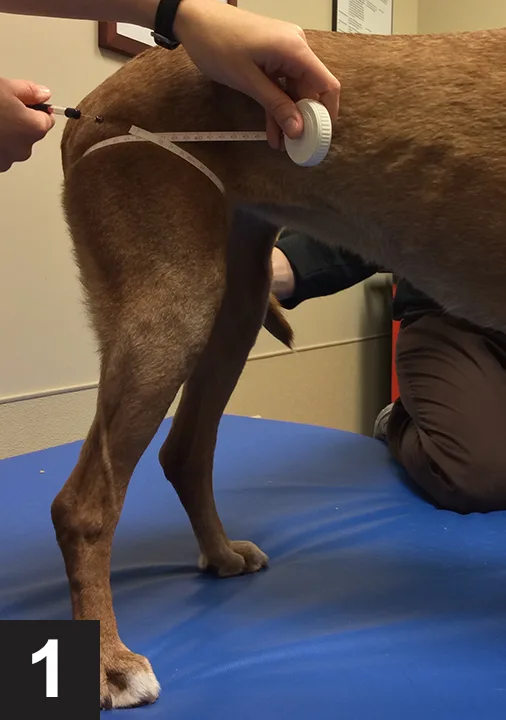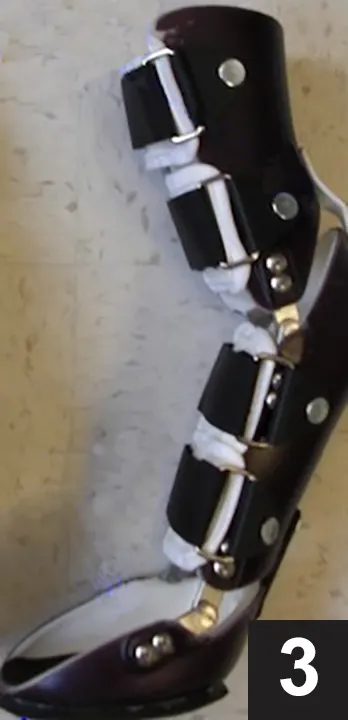Nonsurgical Management of an Achilles Tendon Strain in a Dog

History and Signalment
A 10-year-old spayed Labrador retriever presented to a rehabilitation practice for right pelvic limb lameness that had progressively worsened over the previous 2 weeks. The patient, a field trial competitor, was not receiving medications or supplements but had been placed in a rigid splint by the referring veterinarian and instructed to restrict exercise 5 days prior to presentation.
Physical Examination
At presentation, the patient exhibited a grade 4/5 lameness at a walk with the splint. Trotting was discouraged to avoid further injury. When the patient was standing out of the splint, there was a slight increase in right hock flexion when compared with the left (155 degrees left, 145 degrees right), and the digits of the right pelvic limb also showed increased flexion. A palpable thickening of the right Achilles tendon at its insertion on the calcaneus was noted with the patient in lateral recumbency; the distal 3 cm of the tendon was approximately twice the width of the contralateral Achilles tendon. The right hock showed increased flexion (35 degrees) with the stifle in a fixed extended position (left hock, 45 degrees). Direct palpation of the thickened area and end-range hock flexion resulted in apparent mild discomfort. The right thigh circumference (Figure 1), measured with a Gulick 2 spring-weighted tape measure while patient was standing was 1 cm less than the left.

Figure 1. Demonstration of thigh circumference measurement using a Gulick 2 spring weighted tape measure.
Diagnostics
Radiographs revealed soft-tissue swelling just proximal to the calcaneus; no bony abnormalities were appreciated.
Diagnostic ultrasound revealed loss of normal architecture and echogenicity in the distal 3 cm of the tendons that make up the Achilles complex, with multiple small hypoechoic areas in the common calcaneal and gastrocnemius branches (Figure 2). The superficial digital flexor tendon (SDFT) appeared normal; however, edema could be seen within the subcutaneous tissues over the tendon. Fibers of each part of the Achilles complex could be followed to the calcaneal attachment and appeared intact, but the fiber was in a disorganized pattern (ie, loss of normal striations) and swollen. Based on ultrasound appearance, the diagnosis was consistent with a grade II/IV strain (ie, no core lesion, no full tear) of both the common calcaneal and gastrocnemius tendons.

Figure 2. Ultrasound of the Achilles complex showing loss of echogenicity in the distal gastrocnemius (gastroc) and common calcaneal tendons (common) as they attach to the calcaneus. The white lines demarcate the approximate region of the common calcaneal tendon where minimal echogenicity is seen. The superficial digital flexor tendon (SDFT) has normal echogenicity.
Treatment
A custom orthosis (Animal Orthocare) (Figure 3) was fitted to replace the rigid splint one month postinjury to maintain the hock in extension during tendon healing. Wear time was gradually increased over 3 days, with the patient being confined until the orthosis was worn full time. A 2-week adaptation period followed that included weight shifting and gait patterning exercises with short, leashed walks for elimination. After this initial period, controlled leash walking and access to stairs (with assistance) were allowed.

Figure 3. Custom orthosis to maintain the hock in extension during tendon healing.
Ultrasound imaging at the initial orthosis fitting (2 weeks postpresentation) showed minimal healing response, so autologous platelet-rich plasma (PRP) infiltration (ProTec PRP) was initiated to stimulate healing. PRP was injected into the hypoechoic areas under ultrasound guidance; 2 mL were infiltrated through 2 injection sites (ie, proximal and distal ends of the affected area), and the needle was redirected multiple times as 0.2-mL increments were infused. PRP injections were performed at orthosis fitting so that adequate stability could be provided immediately after stimulating a healing response.
Regular rechecks were scheduled to monitor orthosis fit and tendon healing. Diagnostic ultrasound was repeated at 3 and 6 weeks following PRP injection, and at the 6-week recheck, revealed increased (ie, improved) tendon echogenicity, improved fiber orientation, reduced tendon thickening, and decreased fluid between fibers. Based on these findings, no further PRP intervention was deemed necessary.
Twelve weeks after therapy start, orthosis was gradually reduced, allowing short periods of weight bearing without support. This progressed to strengthening exercises (eg, 3-legged stands, backing up, transitions from a down position directly to a stand) for 12 weeks, after which exercise included swimming q48h and walks out of the brace for gradually increasing lengths.
Follow-up & Outcome
At the 6-month recheck, no lameness was observed. Slight thickening of the tendon remained at the calcaneal attachment, but there was no edema or apparent pain on palpation or hock flexion. Recumbent passive maximal hock flexion was 45 degrees bilaterally; standing hock angles were even at 155 degrees. A follow-up ultrasound was recommended, but the client declined. The patient returned to field trial activities, and the client received instructions to gradually build up retrieving and endurance activity over 2 months. The client was instructed to return for follow-up if any lameness was observed.
Achilles Complex Injury
The Achilles complex is comprised of the tendon of insertion of the gastrocnemius muscle and a common tendon formed from the biceps femoris, semitendinosus, and gracilis muscles.1 The SDFT passes distal to the calcaneus with a fibrous attachment to that bone and is sometimes included as part of the Achilles complex1; however, the tendon does not insert on the calcaneus. Injury to the Achilles complex is typically traumatic in nature, often occurring at or just proximal to insertion on the calcaneus.2 Injuries near the calcaneal attachment typically involve the gastrocnemius or common tendons. Either of the tendons can be involved; however, one study reports gastrocnemius tendon injury alone in 20% of dogs, and injury to all parts of the Achilles complex in 22.2%.3 This study also reported that Labrador retrievers, Doberman pinschers, and border collies were most commonly represented.
When there is significant fiber disruption to the gastrocnemius and common calcaneal tendons, the SDFT will bear increased load with resultant toe curling. There is often a partial plantigrade stance, as the intact SDFT prevents full collapse of the hock to the ground. Radiographs should be performed to rule out other pathologies (eg, fractures), and diagnostic ultrasound may be used to evaluate the architecture of the tendons.
Treatment options include medical and surgical therapies. Nonsurgical options for minor or incomplete tears include exercise restriction, external support, and stimulation of healing with adjunct modalities or regenerative therapies. Therapeutic ultrasound can be used to stimulate healing, reduce inflammation, improve fiber alignment and extensibility, and reduce scar tissue, if present.6 Low-level laser therapy can be used as an adjunct modality to reduce pain and inflammation, and may aid collagen synthesis.7 PRP can be injected directly into the tendon near the lesion to enhance healing by providing autologous growth factors. PRP has been shown to improve tendon healing in animal models.4 It is important to note that NSAIDs should be avoided with the use of PRP as they may affect platelet aggregation.
Surgical management has long been the accepted standard for treatment of severe disruptions or lacerated tendons, and temporary immobilization of the tarsal joint is required to prevent excess load on the repaired tendon postoperatively.2,3 However, surgery is not an option for all patients because of anesthetic risks factors or financial limitations. Deciding between medical and surgical management depends on the degree and chronicity of tendon injury, with chronic cases being more difficult to manage. This case demonstrates successful nonsurgical treatment of a tendon strain. A similar successful case has been reported in the literature.5